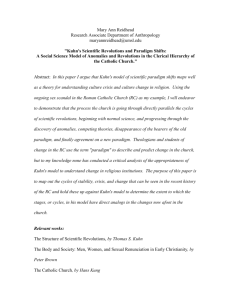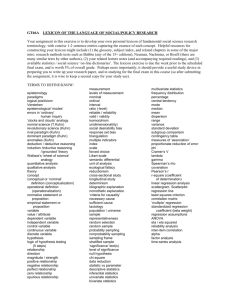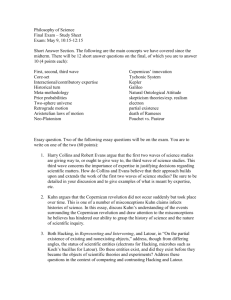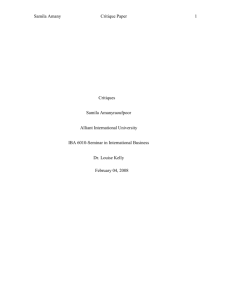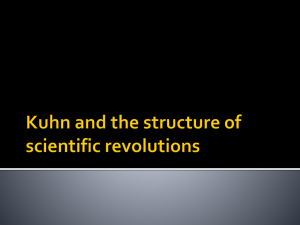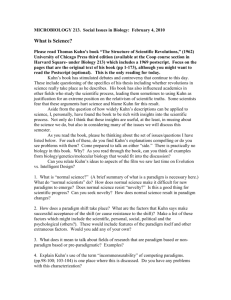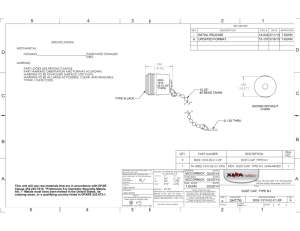Developmental Origins of Scientific Thinking
advertisement
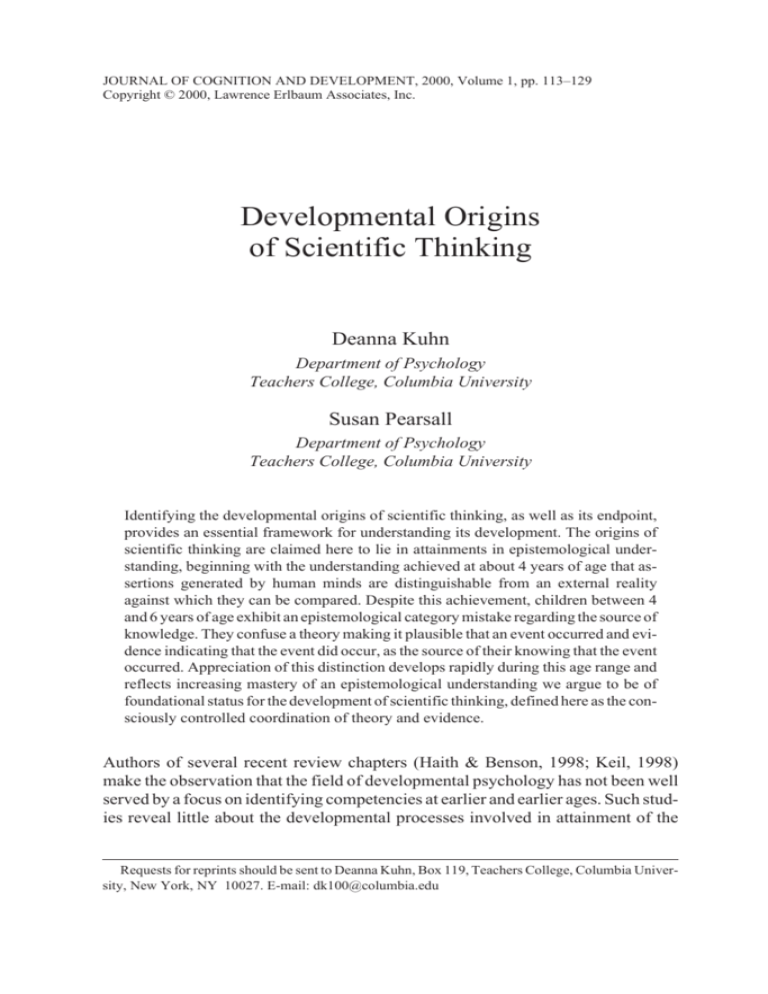
JOURNAL OF COGNITION AND DEVELOPMENT, 2000, Volume 1, pp. 113–129 Copyright © 2000, Lawrence Erlbaum Associates, Inc. Developmental Origins of Scientific Thinking Deanna Kuhn Department of Psychology Teachers College, Columbia University Susan Pearsall Department of Psychology Teachers College, Columbia University Identifying the developmental origins of scientific thinking, as well as its endpoint, provides an essential framework for understanding its development. The origins of scientific thinking are claimed here to lie in attainments in epistemological understanding, beginning with the understanding achieved at about 4 years of age that assertions generated by human minds are distinguishable from an external reality against which they can be compared. Despite this achievement, children between 4 and 6 years of age exhibit an epistemological category mistake regarding the source of knowledge. They confuse a theory making it plausible that an event occurred and evidence indicating that the event did occur, as the source of their knowing that the event occurred. Appreciation of this distinction develops rapidly during this age range and reflects increasing mastery of an epistemological understanding we argue to be of foundational status for the development of scientific thinking, defined here as the consciously controlled coordination of theory and evidence. Authors of several recent review chapters (Haith & Benson, 1998; Keil, 1998) make the observation that the field of developmental psychology has not been well served by a focus on identifying competencies at earlier and earlier ages. Such studies reveal little about the developmental processes involved in attainment of the Requests for reprints should be sent to Deanna Kuhn, Box 119, Teachers College, Columbia University, New York, NY 10027. E-mail: dk100@columbia.edu 114 KUHN AND PEARSALL competency, or about how the competency identified at an early age differs from or evolves into the competency in its more mature forms. Researchers’ efforts, it is argued, would be more productively focused on understanding developmental process and the states of “partial accomplishment” (Haith & Benson, 1998) that mark its progress. Studies of partial accomplishment need to be undertaken within a conceptual framework that identifies both developmental origins and endpoints. Scientific thinking, the topic of this article, is problematic in this respect, as neither origins nor endpoint have been clear. The intellectual skills associated with scientific thinking are ones valued in rigorous thinking more broadly (Kuhn, 1996). It is, thus, unclear whether it is the cognitive competencies of the professional scientist (which only recently have become a focus of empirical study) or of the mature lay person or intuitive scientist that are to be taken as an endpoint (Klahr & Carver, 1995; Kuhn, 1995). A clearly conceptualized endpoint narrows the search for origins and together they define what it is that develops. Our objective here is to identify the developmental origins of scientific thinking. A number of claims have been made regarding early forms of scientific thinking detectable in young children, a few based on experimental data (Ruffman, Perner, Olson, & Doherty, 1993; Sodian, Zaitchik, & Carey, 1991) and many others in more educationally oriented literature highlighting young children’s skills in activities such as observation, description, and classification. Our interest in pursuing the question of developmental origins centers on whether the early childhood years are characterized by any cognitive achievements specific and central to the development of scientific thinking, possibly to the extent of defining its essence. Classification, for example, is a more general cognitive capability with roots evident in infancy (Langer, 1980), and which is clearly necessary for scientific thinking, but at the same time does not define its essence. Are there, in contrast, early attainments that represent the rudiments of scientific thinking and provide the foundation for its further development? SCIENTIFIC THINKING AS THE COORDINATION OF THEORY AND EVIDENCE The conceptualization of mature scientific thinking that has guided our work is one sufficiently broad to encompass skilled thinking both within and outside of professional science. It is also broadly compatible with the conceptualizations of others who have studied the topic (see DeLoache, Miller, & Pierroutsakos, 1998; Klahr, 1999; Kuhn, Garcia-Mila, Zohar, & Andersen, 1995; Moshman, 1998, for review). The essence of mature scientific thinking, we claim, is the coordination of theory and evidence in a consciously controlled manner. The qualifier “in a consciously controlled manner” is essential because the thinking of even very young children SCIENTIFIC THINKING 115 has been claimed to involve the construction of theories, as a means of understanding the world, and their revision in the face of evidence (Wellman & Gelman, 1998). It does not follow, however, that young children have explicit awareness of their theories or of the fact that they are undergoing revision. Indeed, it is unlikely that they do, and research we review later in this article supports this assumption. Mature scientific thought, on the other hand, is characterized by a now widely accepted postpositivist philosophy of science as involving the examination and interpretation of evidence within a theoretical framework that shapes all phases of scientific activity (Kitcher, 1993). Thus, both young intuitive scientists and mature professional scientists make use of both theory and evidence in their thinking. That is not where the difference between them lies. Rather, the difference is that in the case of the mature scientist, the coordination of theory and evidence is carried out under a high degree of conscious control (and therefore explicit, consistent, and demanding criteria). Accordingly, the development in scientific thinking believed to occur across the childhood and adolescent years might be characterized as the achievement of increasing cognitive control over the coordination of theory and evidence. This achievement, note, is metacognitive in nature because it entails mental operations on entities that are themselves mental operations. In this respect, Inhelder and Piaget’s (1958) characterization of scientific thinking as involving “operations on operations” is correct. Contrary to their depiction of second-order operations as emerging at adolescence, however, it has subsequently been recognized that metacognitive thinking about one’s own thought begins to develop much earlier (Brown, 1997; Kuhn, in press-a)—a fact highlighted by studies examined in this article and, in particular, those coming from research on theory of mind (see Flavell, 1999, for review). Empirical research on scientific thinking, in contrast, has shown that it may not develop fully even by adulthood (Kuhn et al., 1995). One of the purposes of this article is to connect these two bodies of research—one emphasizing early competence and the other later lack of competence. Empirical studies of scientific thinking skills can be divided into two categories corresponding to two broad phases of scientific activity: the investigative, in which experiments are designed and evidence sought and the inferential, in which the resulting evidence is interpreted. Inferential skills entail a path from evidence to theory—of interpreting various patterns of evidence, drawing conclusions, and exhaustively considering alternative conclusions consistent with the evidence. Investigative skills, in contrast, entail a path from theory to evidence, in particular in the design of experiments that have the potential to yield informative evidence bearing on the theory. As Klahr (1999) notes, few researchers have investigated this full range of skills within a single study. Nonetheless, as our own research and that of a number of others (Amsel & Brock, 1996; Klahr, Fay, & Dunbar, 1993; Koslowski, 1996; Kuhn, in press-b; Kuhn, Amsel, & O’Loughlin, 1988; Kuhn et al., 1995; Kuhn, Schauble, & Garcia-Mila, 1992; Penner & Klahr, 1996; Schauble, 116 KUHN AND PEARSALL TABLE 1 Four Types of Theoretical Claims Type Example Supporting Evidence T1. Category claim Plants are living things. Plants share the category characteristics of living things. T2. Event claim This plant died. T3. Causal or explanatory claim The plant died because of inadequate sunlight. T4. Explanatory system claim A multivariable process of photosynthesis maintains plant life. The plant has turned brown and is not growing (i.e., the plant no longer shares category characteristics of living things). Plants not exposed to sunlight die, and most plants exposed to sunlight remain alive (i.e., covariation between alleged causal antecedent and outcome). Plants not exposed to the multiple conditions required for photosynthesis do not remain alive. Disconfirming Evidence Plants lack some category characteristics of living things. The plant continues to show the category characteristics of living things. Some groups of plants not exposed to sunlight remain alive (i.e., lack of covariation between alleged causal antecedent and outcome). Plants not exposed to the multiple conditions required for photosynthesis remain alive. 1990, 1996) has established, weaknesses are common among lay adults, as well as adolescents and children, with respect to both sets of skills. The investigation of origins may offer some insight into later lack of development of scientific thinking, a possibility we return to. What Is a Theory? If the coordination of theory and evidence is regarded as the essence of scientific thinking and we wish to identify its developmental origins in young children, it is essential, as a first step, to define our terms precisely. What counts as a theory, what counts as evidence, and what must one do to coordinate them? What counts as a theory has in fact been the topic of debate in cognitive development literature (Wellman & Gelman, 1998), with the term used in different ways within different research traditions. In Table 1 we portray four possible uses of the term theory, each of which has been implicit in one or more lines of research, beginning with the least stringent (T1) and progressing to the most stringent (T4) definition of the term. In the second column we give examples of each theory type, and in the two final columns we give examples of relevant evidence capable of supporting or disconfirming the theory. Evidence is defined as empirical observations distinguishable from the theory and bearing on it. SCIENTIFIC THINKING 117 T1 and T2 are simple knowledge claims, often referred to as beliefs. The two types are not entirely distinct from one another, as many T1 claims can be converted to T2 claims and vice versa. For example, the T2 claim This plane crashed is convertible to the T1 claim This plane is in a category of planes that have crashed. In contrast to the first two types, T3 and T4 theoretical claims include an explanation of why the claim is correct. T3 claims do so by invoking a single factor as cause. T4 theoretical claims are also explanatory, but in the more complex form of invoking a system of interconnected factors as an explanation. Some researchers have reserved theory to refer to theories of the T4 type, claiming that even very young children’s theoretical knowledge has internal coherence and is structured around a set of core assertions interconnected by causal principles (Carey, 1986; Wellman & Gelman, 1998), even though the child lacks explicit awareness of the theory. In this analysis, in contrast, although noting the distinctions among them, we treat all four types in Table 1 as lying on a single continuum and therefore warranting a common label. Our justification for doing so is that, although they differ in complexity, each makes a claim that is potentially falsifiable by empirical evidence.1 This common characteristic, we believe, is sufficient to link them along a single continuum. We refer to all four types by the single term theoretical claim (thereby encompassing both the claim label more common to the T1 and T2 types and the theory label more common to the T3 and T4 types). Each of the four is falsifiable by the kinds of evidence indicated in the third and fourth columns of Table 1. Again, the requirement for treating an observation as evidence is that it stand apart from the theoretical claim and bear on it. Linking the four types of theoretical claims in Table 1 is important to our objective of identifying developmental origins of scientific thinking. Presumably, the coordination of theory and evidence that we define as scientific thinking will be observable first with respect to the more elementary theory types (T1 or T2) and the simplest kinds of evidence associated with them. Only later might a child become capable of reasoning about (as opposed to reasoning with) more complex theories and about how evidence bears on them. Complex instances of theory–evidence coordination involve multiple interrelated theoretical claims and multiple kinds of evidence bearing on them. Here we are asking simply how theory–evidence coordination could occur in its most rudimentary form. 1Although it can be argued that unfalsifiable theories have legitimacy and value, we do not take on that debate here. Also, in our connecting a range of claims from simple assertions or beliefs to complex theories, we do not mean to deny the importance of distinctions among them, as well as other related constructs, such as hypothesis, prediction, and explanation. To address these distinctions would take us away from our purpose, which is to identify the common characteristic the types in Table 1 share as claims that can be examined in the light of evidence. 118 KUHN AND PEARSALL Coordinating a Theoretical Claim With Evidence Three requirements must be met if it is to be claimed that one is engaged in the coordination of theory and evidence. First, the theoretical claim must be recognized as potentially false. If it is not falsifiable, empirical observations could be incorporated within it, but they do not stand apart from it and bear on its correctness. The second and third requirements follow from the first: Evidence must be recognized as the means of falsifying a theoretical claim, and, finally, theoretical claim and evidence must be recognized as distinct epistemological categories—evidence must be distinguishable from the theory itself and bear on its correctness. The first requirement—that a theoretical claim be understood as possibly false—is recognizable as a core topic in a now sizable body of research on what has come to be called children’s theory of mind (Flavell, 1999). Although less directly related, research relevant to the second requirement—that evidence be recognized as the means of falsifying a theoretical claim—also exists within this literature, under the heading of children’s awareness of the sources of their knowledge. In the next section, we identify the most pertinent findings in these two categories within the theory-of-mind literature and consider their implications with respect to the development of scientific thinking. The third requirement—that theory and evidence be recognized as distinct epistemological categories—we consider in a third section of the article. Here we turn to some findings of our own from a study (Kuhn & Pearsall, 1998a) of preschoolers’ skills in the differentiation of theory and evidence. EPISTEMOLOGICAL FOUNDATIONS OF SCIENTIFIC THINKING IN THEORY OF MIND Understanding False Belief By the age of 3, children are able to think about thinking as a human activity that they and others engage in. They can represent mental states, distinguishing, for example, thinking about a dog from looking at one (Estes, Wellman, & Woolley, 1989), and they have begun to use mental-state concepts such as desire and intention as a means of explaining their own and others’ behavior (Wellman, 1988). Yet children of this age show a notable limitation in their conceptualization of the products of this thinking. They treat the universe of beliefs people hold and the assertions that express these beliefs as isomorphic to an external reality. An account of an event differs from the event itself only in that one exists on a representational plane whereas the other is perceived directly. In other words, the world is a simple one in which things happen and we can tell about them. There are no inaccurate renderings of events. SCIENTIFIC THINKING 119 The most familiar source of evidence for this characterization is young children’s poor performance in the now classic false-belief task. Three-year-olds believe that a newcomer will share their own accurate knowledge that a candy container in fact holds pencils (Perner, 1991; Wimmer & Perner, 1983). It is impossible to the child that the other person could hold a belief that the child knows to be false. Underlying these claims is the naive epistemological theory that beliefs are nothing more or less than mental copies of reality. In the age range of 3 to 4 years, children achieve the understanding of assertions as the expression of someone’s belief. Perner (1991) characterized this acquisition as the ability to metarepresent—in other words to mentally model the human representational function. In so doing, the child comes to recognize that as expressions of humans’ representational capacity, assertions do not necessarily correspond to reality. It is not understood why this achievement occurs at precisely this time. It may be that the child accrues enough experience with human knowing (of both self and others) to link the products of knowing—beliefs and assertions— to the generative process that gives rise to them, although domain-general increases in processing capacity that allow the child to simultaneously represent two perspectives may be a contributing factor (Frye, Zelazo, & Palfai, 1995; Halford, Wilson, & Philips, 1998). In the absence of this achievement, mental representations are confined to a single reality defined by what the individual takes to be true. The evaluation of falsifiable claims that is central to science cannot occur. For this reason, we regard this early theory-of-mind accomplishment—one in which assertions are understood as generating from human minds and are recognized as potentially discrepant from an external reality to which they can be compared—as a milestone of foundational status in the development of scientific thinking, as well as argumentive thinking more broadly (Kuhn, 1991, 1993). If assertions do not necessarily correspond to reality, they become susceptible to evaluation vis-à-vis the reality from which they are now distinguished. The complexity of theoretical claims that a 4-year-old is able to evaluate as potentially false is extremely limited. The child is capable of little more, really, than determining whether a claim regarding some physical state of affairs does or does not correspond to a reality directly knowable by the child. Nonetheless, the stage has been set for the appearance of the kinds of coordinations between more complex theoretical claims and forms of evidence that are more readily recognizable as scientific thinking. Awareness of the Sources of One’s Knowledge The second requirement we specified for coordinating theory and evidence is recognizing the status of evidence as the means of falsifying a theoretical claim. To ap- 120 KUHN AND PEARSALL preciate the status of evidence, one must be sensitive to the issue of how one knows something. Such sensitivity brings us very close to a second line of research within the theory-of-mind literature, one that probes children’s awareness of the sources of their knowledge. The common finding these studies report is that the preschool age range is a time of rapid development in the awareness of sources of one’s knowledge. In studies by Gopnik and colleagues (Gopnik & Graf, 1988; O’Neill & Gopnik, 1991), children maintained little awareness of the source of newly acquired knowledge. They were unable, for example, to indicate whether they had just learned the contents of a drawer from seeing them or being told about them (Gopnik & Graf, 1988). Furthermore, even when children initially identified the source of their knowledge correctly, they did not remember it later. Work by Taylor, Esbensen, and Bennett (1994) indicates that young children show little awareness of when they acquired new knowledge, claiming, for example, that a new concept just taught to them was one they had always known. Improvement in these respects is seen during the same preschool age range studied in the research on false belief. Five-year-olds’ performance in the Gopnik and Graf study, for example, was significantly better than that of 3-year-olds, although less than perfect. Rapid improvement in this same age range was reported by O’Neill, Astington, and Flavell (1992) in a study of children’s understanding that different sense modalities (e.g., looking at an object vs. feeling it) are the sources of different kinds of knowledge, as well as by Woolley and Bruell (1996) in distinguishing imagination versus seeing or being told as sources of one’s mental representations. Sensitivity to the origins of one’s knowledge, thus, appears to emerge during the same age range as the acquisition of an understanding of false belief, with the latter possibly mastered slightly earlier (by age 4 according to most studies). The epistemological achievement of awareness of the sources of one’s knowledge is, of course, critical in scientific thinking. One needs to know and be able to justify exactly how one knows something to be the case. In comparison to when one acquired a piece of knowledge (Taylor et al., 1994) or even what form the evidence took (Gopnik & Graf, 1988), a fundamental issue in scientific thinking and discourse is whether the source of an assertion is a theory (that makes it plausible that an event occurred) or evidence (indicating that the event did occur). Hence, the two sources of knowledge are of differing epistemological status. It is recognition of the distinction in status between them that we stipulated earlier as a third requirement for coordinating theory and evidence. By contrast, note that the sources of knowledge in Gopnik and Graf’s (1988) study are arbitrary. The sources could as well have been reversed, with the child told the contents of Drawer A and shown the contents of Drawer B, rather than the reverse. Indeed, one might make the alternative interpretation that children forgot the sources not through lack of cognitive competence but because these sources were insignificant to them once the knowledge (the contents of the drawers) had SCIENTIFIC THINKING 121 been acquired. In the study we describe in the next section, in contrast, the difference between the two sources is of fundamental importance because they are of differing epistemological status—one a theory, as a source supporting the plausibility of a claim, and the other evidence, as a source bearing on the truth of the claim. DISTINGUISHING THEORY AND EVIDENCE AS SOURCES OF KNOWLEDGE The rationale for the study described in this section derives from our earlier work (Kuhn et al., 1988; Kuhn et al., 1995; Kuhn & Pearsall, 1998b; Kuhn et al., 1992) showing that older children, adolescents, and even adults may confuse theory and evidence. Specifically, this work has shown, they are likely to offer a theoretical claim of the T4 type as evidence for the correctness of a T3 theoretical claim. In other words, to support a T3 theoretical claim that a particular antecedent is a cause of an outcome, they give an elaborated, T4 theoretical explanation (typically involving additional variables) of the mechanisms responsible for the existence of this causal connection, an explanation that serves to make the causal connection plausible. Numerous studies have documented the importance of explanation of mechanism in adults’ causal reasoning (see Kuhn, in press-b, for review), and yet all theories of mechanism are limited by the same serious flaw: They cannot by themselves falsify a theoretical claim of causality between an antecedent and outcome. We thus wondered whether young children would make a similar error of confusing the epistemological categories of theory and evidence in reasoning about simpler T1 or T2 theoretical claims. In our study (Kuhn & Pearsall, 1998a), 4- and 6-year-olds were shown a sequence of pictures in which, for example, two runners compete in a race. Certain cues suggest a T3 theory as to why one will win; for example, one has fancy running shoes and the other does not. The final picture in the sequence provides evidence of the outcome; for example, one of the runners holds a trophy and exhibits a wide grin. When children are asked to indicate the outcome and to justify this knowledge, 4-year-olds show a fragile distinction between the two kinds of justification—How do you know? and Why is it so?—in other words, the evidence for their claim (the outcome cue in this case) versus their explanation for it (the initial theory-generating cue). Rather, the two merge into a single representation of what happened, and the child tends to choose as evidence of what happened the cue having greater explanatory value as to why it happened. Thus, in the race example, young children often answered “How do you know [he won]?” not with evidence (“He’s holding the trophy”) but with a theory of why this state of affairs makes sense (e.g., “Because he has fast sneakers”). 122 KUHN AND PEARSALL TABLE 2 Numbers of Spontaneous and Prompted Evidence Response Patterns Shown by Each Participant 4-Year-Olds Spontaneous M 0 0 0 0 0 0 1 1 2 2 2 2 3 3 5 — 1.40 6-Year-Olds Prompted 0 1 1 1 1 1 1 1 2 2 2 3 3 4 5 — 1.87 Spontaneous 1 1 1 2 3 4 4 4 4 4 4 4 4 5 5 6 3.50 Adults Prompted 1 2 2 2 3 4 4 5 5 5 5 5 6 6 6 6 4.19 Spontaneous 6 6 6 6 6 6 6 6 — — — — — — — — 6.00 Prompted 6 6 6 6 6 6 6 6 — — — — — — — — 6.00 Note. Maximum = 6. From Kuhn & Pearsall (1998b). Similarly, in another set of pictures in which a boy is shown first climbing a tree and then down on the ground holding his knee, “How do you know [that he fell]?” was often answered, “Because he wasn’t holding on carefully.” Children who gave these kinds of responses to “How do you know?” were asked a follow-up question, “How can you be sure this is what happened?” This evidence prompt elicited a shift from a theory-based to an evidence-based response for some children on some items. Still, even with this prompt, 4-year-olds give evidence-based responses on average to less than a third of the items, although almost all 4-year-olds exhibit a mixture of theory-based and evidence-based responses, as shown in Table 2. As also seen in Table 2, these confusions between theory and evidence diminish sharply among 6-year-olds, who still make mistakes but who a majority of the time distinguish the evidence for their event claim from a (T3) theoretical explanation that makes the claim plausible. A group of adults to whom these items were administered, in contrast, never exhibited such confusions. The data from this study are very simple, but we believe they reveal a theoretically significant characteristic of preschoolers’ epistemological understanding. They do not imply that 4-year-olds can never answer “How do you know?” questions. Indeed, children of this age do so commonly, when a justification for their SCIENTIFIC THINKING 123 claim is readily available (e.g., How do you know it’s a zebra? Because it has stripes.). Rather, the findings suggest that children who have not yet achieved the epistemological understanding in question do not sharply distinguish justifications of differing epistemological status when multiple cues are present that offer different types of justifications. It is also important to emphasize that 6-year-olds who have achieved this epistemological understanding still differentiate theory and evidence in only a limited sense and set of contexts. The child is able to distinguish evidence for the claim that an event occurred from a causal theory that makes occurrence of the event plausible. The evidence in question is simply evidence that the event occurred (e.g., the runner won the race), which is the (T2) claim under consideration. A theory as to why or how the event occurred is a separate entity (a theoretical claim of type 3 or 4). As discussed earlier, such a theory is often invoked to support the plausibility of a T2 event claim, but it remains only a theory and, hence, one that properly requires its own supporting evidence. Children in the study just described are not called on to identify evidence for such a theory (of why the event occurred) but merely evidence that the event itself occurred. Evidence capable of supporting a (T3) causal theory is of a more complex form, covariation evidence being the most common. It is these more complex forms of evidence that older children and adults have been found to confuse with their own causal theories in our own and others’ research (Klahr et al., 1993; Kuhn et al., 1988; Kuhn et al., 1995; Kuhn et al., 1992; Schauble, 1990, 1996). Selectively chosen evidence is relegated to the status of illustrating the claim, rather than standing apart from it and bearing on its correctness. Indeed, in response to the same “How do you know?” question that was the focus of the study described in this section, older individuals often give theory-based responses (i.e., because this is the way it should be or makes sense to be), even when their attention is specifically directed to the evidence (“Do any of the records you’ve looked at here say anything about whether ______ makes a difference?”). Thus, in many respects these confusions displayed by older individuals parallel the more elementary ones described in this section. CONNECTIONS TO OTHER LITERATURE ON EARLY DEVELOPMENT OF SCIENTIFIC THINKING In this section, we examine previous research on early developments in scientific thinking in light of the framework that has been developed here. The recognition of theoretical claim and evidence as distinct epistemological categories, we have argued, is an essential requirement for the coordination of theory and evidence. Awareness that a theoretical claim can be false and a sensitivity to the sources of one’s claims, shown in the theory-of-mind literature to develop in the 3- to 5-year 124 KUHN AND PEARSALL age range, provide an essential foundation for this subsequent achievement, which has developed substantially but is still not fully consolidated by the age of 6 years (as seen in Table 2). Distinguishing Determinate From Indeterminate Evidence If these achievements represent the origins of scientific thinking, as we wish to claim, it is nonetheless clear that much remains to develop. In particular, nothing has yet been said about a child’s understanding of what bearing evidence has on theoretical claims, assuming its differentiation from and connection to such claims is appreciated. A line of research originating with Pieraut-Le Bonniec (1980) and furthered more recently in studies by Ash, Torrance, Lee, and Olson (1993) and by Fay and Klahr (1996) examines one fundamental characteristic of evidence— whether it is determinate or indeterminate in establishing the correctness of a theoretical claim. These studies show some competence by age 5 in recognizing determinate evidence, but still considerable difficulty in the age range of 5 to 7 years in correctly interpreting evidence as indeterminate, in other words as supporting more than one conclusion. As in the achievement in epistemological understanding examined in the preceding section of this article, early developments described in the theory-of-mind literature would appear to provide a foundation for the development of this understanding. In this case, most salient is the distinction children have begun to appreciate by 5 years of age between the verbs think and know (Moore, Bryant, & Furrow, 1989). Strategic Choice of Determinate Over Indeterminate Evidence Two remaining studies in the scientific thinking literature warrant particular attention as they offer alternative accounts to the one advanced in this article with regard to the developmental origins of scientific thinking. Sodian et al. (1991) and Ruffman et al. (1993) each take a different tack in identifying early forms of scientific thinking. Sodian et al. asked children to choose the more informative of two tests to find out if a mouse was a large or small one by placing food in a box overnight. Two boxes were available, one with a large opening (able to accommodate a large or small mouse) and one with a small opening (big enough for only the small mouse to pass through). The performance of 6-year-olds in their study was weak, but by 7 years of age, most children correctly chose the more informative test. Although Sodian et al. did not cast their work in these terms, their design invokes the same contrast between determinate and indeterminate evidence that is the focus of the research by Fay and Klahr (1996), Ash et al. (1993), and, before them, Pieraut- SCIENTIFIC THINKING 125 Le Bonniec (1980). Sodian et al. focused instead on their findings as illustrating their participants’ differentiation of theory and evidence, a claim we do not find convincing. Their task requires the child to choose the more informative of two potential forms of evidence. The distinction between what is the theory (big mouse or small mouse) and what is the evidence (big or small opening) is never in question. More broadly, the ability to seek appropriate evidence capable of disconfirming a theory (by establishing its lack of correspondence with evidence) can in fact be demonstrated at even younger ages, as illustrated, for example, by the 2-year-old who knows that opening the closet door is capable of disconfirming her claim that it is the whooshing sound of a ghost inside her closet that is keeping her awake. It will nonetheless be a number of years before this 2-year-old comes to appreciate the epistemological status of evidence as standing apart from a theory and bearing on it. For now, there exists either a state of affairs that can be described as ghost in the closet or one that must be described as no ghost in the closet and various strategic maneuvers that may have the effect of transforming the depiction of reality from one state to the other. The Sodian et al. (1991) study does show children’s capacity to behave strategically, in making a choice that involves the recognition of the superiority of determinate over indeterminate evidence. Strategic behavior of various sorts has been well documented among children as young as 2 or 3 years old (Brown, 1997). Still, the selection of evidence that will be informative in evaluating a theory has been found to be an obstacle to effective scientific thinking in the numerous studies that have examined it (Klahr, 1999; Klahr et al., 1993; Kuhn et al., 1988; Kuhn et al., 1995; Kuhn et al., 1992; Penner & Klahr, 1996; Schauble, 1990, 1996). In this respect, the ability Sodian et al. identified to make an effective choice of evidence within a highly constrained set of options is a significant strategic achievement. Identifying Correspondences Between Theory and Evidence The study by Ruffman et al. (1993) is a detailed one comprising multiple experiments, but the main finding is that children in the age range of 5 to 7 years old are successful in coordinating theory and evidence in the sense that they can draw appropriate inferences from evidence (e.g., dolls who choose red food over green food) to theory (e.g., the dolls prefer red food to green) or from theory to evidence (in the form of a prediction of the dolls’ food choice). This remained the case even when the child’s own belief was that the theory was false. What is the competence that Ruffman et al. (1993) identified as in place by this age? Their discussion suggests that it is the ability to identify correspondences between theories and data—to reason from one to the other. The study does appear to 126 KUHN AND PEARSALL demonstrate the ability of most 5- to 7-year-olds to do this. The fact is, however, that such an ability can be observed at far earlier ages than those examined by Ruffman et al. Indeed, some might argue that the ability to draw inferences from empirical data or to make predictions from implicit theories—to identify correspondences between theories and data—can be observed as early as the sensorimotor level (witness Piaget’s infant who recognizes that movement of his leg causes the movement of the attached rattles). In the social domain, Wellman (1988) and others have traced the very early development of attributions of intention and desire (theories) to explain one’s own or another’s behavior. Such theories, based on regularities observed in one’s environment, develop even earlier in the physical domain—for example, the theory that glass objects break when dropped as an explanation or prediction of data that correspond to this theory. What is new, developmentally speaking, in the late preschool years is the ability to reason appropriately about such correspondences when one’s own belief is counter to the theory. This is the achievement discussed earlier that is assessed by the false-belief task in the theory-of-mind literature (the actor’s search of that location to obtain candy can be explained—or predicted—by his or her belief that the container contains candy, even though I know better). This achievement, however, is not the focus of Ruffman et al.’s analysis. The particular correspondences between theories and patterns of evidence that a child is able to identify, and therefore to use as a basis for inference or prediction, increase in complexity with development. What needs to be recognized, however, especially as it is somewhat counterintuitive to anyone who has mastered the epistemological distinction in question, is the one thing the identification of correspondences between theories and patterns of evidence does not entail, and that is a firm differentiation between the two. Theory and evidence can fit together into a coherent depiction of a state of affairs, in the sense of being consistent with and implying one another, in the absence of a recognition of their differing epistemological status. Indeed, this is precisely what the data from our research described earlier (Kuhn & Pearsall, 1998a) show, supporting the claim that appreciation of the epistemological distinction between theory and evidence is a foundational achievement in the development of scientific thinking. Only with a firm distinction between them can one engage in the genuine coordination of theory and evidence—the consciously controlled evaluation of one in the light of the other—that we have depicted as the essence of scientific thinking. IMPLICATIONS FOR A THEORY OF THE DEVELOPMENT OF SCIENTIFIC THINKING As argued at the outset of this article, a conceptualization identifying developmental origins and endpoints provides the framework from which process-oriented studies can proceed. Our interest in pursuing the question of developmental origins SCIENTIFIC THINKING 127 of scientific thinking centered on whether any cognitive achievements can be identified during the early childhood years that are specific to this age period and central to the development of scientific thinking, in the sense of defining its essence. This analysis, we believe, beyond contributing to identification of the origins of scientific thinking, suggests a picture of what it is that is developing and toward what endpoint. Such a conceptualization is particularly important in the case of a complex cognitive skill like scientific thinking that is multifaceted and has tended not to be precisely defined. The early epistemological achievements on which this article focuses—recognition that assertions generated by human minds can be differentiated from an external reality against which they can be compared, and appreciation of the differing epistemological status of theory and evidence as sources of knowledge—we believe, are central to scientific thinking and set in place an essential foundation for its further development. An essential epistemological requirement of scientific thinking is to be clear regarding the sources of one’s knowledge—knowing how one knows. The distinction between theory and evidence as sources of knowledge is foundational in this respect. Congruent with identification of these origins is a conception of scientific thinking skill as evolving toward an endpoint of explicit, metacognitive control over the differentiation and coordination of theory and evidence. Although knowing how one knows is central to scientific thinking, it is not unique to it. To the contrary, its centrality to many forms of higher level thinking (Kuhn, 1996; Olson & Astington, 1993) suggests that it should be a focus of attention for both researchers and educators concerned with all age groups from preschoolers to mature adults (Olson & Astington, 1993). People of all ages and backgrounds, not just professional scientists, need to be attuned to the relevant epistemological categories (of fact, opinion, theory, and evidence) as a means of conceptualizing how they know what they know, and they stand to benefit from this focus. In this respect, as Einstein (1954) reminded us, it is essential that researchers studying scientific thinking make a point of connecting it to thinking more broadly. A lack of metacognitive attention to how one knows, and the consequent limitations in epistemological understanding, we believe go a long way toward explaining the limited development of scientific thinking skills that has been observed in adolescents and adults. REFERENCES Amsel, E., & Brock, S. (1996). The development of evidence evaluation skills. Cognitive Development, 11, 523–550. Ash, A., Torrance, N., Lee, E., & Olson, D. (1993). The development of children’s understanding of the evidence for beliefs. Educational Psychology, 13, 371–384. Brown, A. (1997). Transforming schools into communities of thinking and learning about serious matters. American Psychologist, 52, 399–413. 128 KUHN AND PEARSALL Carey, S. (1986). Cognitive science and science education. American Psychologist, 41, 1123–1130. DeLoache, J., Miller, K., & Pierroutsakos, S. (1998). Reasoning and problem solving. In W. Damon (Series Ed.) & D. Kuhn & R. Siegler (Vol. Eds.), Handbook of child psychology: Vol. 2. Cognition, language, and perception (5th ed., pp. 801–850). New York: Wiley. Einstein, A. (1954). Ideas and opinions. New York: Crown. Estes, D., Wellman, H., & Woolley, J. (1989). Children’s understanding of mental phenomena. In H. Reese (Ed.), Advances in child development and behavior (pp. 41–87). New York: Academic. Fay, A., & Klahr, D. (1996). Knowing about guessing and guessing about knowing: Preschoolers’ understanding of indeterminacy. Child Development, 67, 689–716. Flavell, J. (1999). Cognitive development: Children’s knowledge about the mind. Annual review of psychology, 50, 21–45. Frye, D., Zelazo, P. D., & Palfai, T. (1995). Theory of mind and rule-based reasoning. Cognitive Development, 10, 483–527. Gopnik, A., & Graf, P. (1988). Knowing how you know: Young children’s ability to identify and remember the sources of their beliefs. Child Development, 59, 1366–1371. Haith, M., & Benson, J. (1998). Infant cognition. In W. Damon (Series Ed.) & D. Kuhn & R. Siegler (Vol. Eds.), Handbook of child psychology: Vol. 2. Cognition, language, and perception (5th ed., pp. 199–254). New York: Wiley. Halford, G. S., Wilson, W. H., & Philips, S. (1998). Processing capacity defined by relational complexity: Implications for comparative, developmental, and cognitive psychology. Behavioral and Brain Sciences, 21, 803–864. Inhelder, B., & Piaget, J. (1958). The growth of logical thinking from childhood to adolescence. New York, Basic. Keil, F. (1998). Cognitive science and the origins of thought and knowledge. In W. Damon (Series Ed.) & R. Lerner (Vol. Ed.), Handbook of child psychology: Vol. 1. Theoretical models of human development (5th ed., pp. 341–414). New York: Wiley. Kitcher, P. (1993). The advancement of science. New York: Oxford University Press. Klahr, D. (1999). Exploring science: The cognition and development of discovery processes. Cambridge, MA: MIT Press. Klahr, D., & Carver, S. (1995). Scientific thinking about scientific thinking. In D. Kuhn, M. GarciaMila, A. Zohar, & C. Andersen, Strategies of knowledge acquisition. Monographs of the Society for Research in Child Development, 60(4, Serial No. 245, 137–151). Klahr, D., Fay, A., & Dunbar, K. (1993). Heuristics for scientific experimentation: A developmental study. Cognitive Psychology, 25, 111–146. Koslowski, B. (1996). Theory and evidence: The development of scientific reasoning. Cambridge, MA: MIT Press. Kuhn, D. (1991). The skills of argument. New York: Cambridge University Press. Kuhn, D. (1993). Science as argument: Implications for teaching and learning scientific thinking. Science Education, 77, 319–337. Kuhn, D. (1995). Scientific thinking and knowledge acquisition. In D. Kuhn, M. Garcia-Mila, A. Zohar, & C. Andersen, Strategies of knowledge acquisition. Monographs of the Society for Research in Child Development, 60(4, Serial No. 245, 152–157). Kuhn, D. (1996). Is good thinking scientific thinking? In D. Olson & N. Torrance (Eds.), Modes of thought: Explorations in culture and cognition (pp. 261–281). Cambridge, England: Cambridge University Press. Kuhn, D. (in press-a). Metacognitive development. In L. Balter & C. Tamis Le-Monda (Eds.), Child psychology: A handbook of contemporary issues. Philadelphia: Psychology Press. Kuhn, D. (in press-b). Why development does (and doesn’t) occur: Evidence from the domain of inductive reasoning. In R. Siegler & J. McClelland (Eds.), Mechanisms of cognitive development: Neural and behavioral perspectives. Mahwah, NJ: Lawrence Erlbaum Associates, Inc. SCIENTIFIC THINKING 129 Kuhn, D., Amsel, E., & O’Loughlin, M. (1988). The development of scientific thinking skills. Orlando, FL: Academic. Kuhn, D., Garcia-Mila, M., Zohar, A., & Andersen, C. (1995). Strategies of knowledge acquisition. Society for Research in Child Development Monographs, 60(4, Serial No. 245). Kuhn, D., & Pearsall, S. (1998a). Metacognitive dimensions of knowledge acquisition: Awareness of theory and evidence as sources of one’s knowledge. Unpublished manuscript, Teachers College, Columbia University, New York. Kuhn, D., & Pearsall, S. (1998b). Relations between metastrategic knowledge and strategic performance. Cognitive Development, 13, 227–247. Kuhn, D., Schauble, L., & Garcia-Mila, M. (1992). Cross-domain development of scientific reasoning. Cognition and Instruction, 9, 285–327. Langer, J. (1980). The origins of logic: Six to twelve months. New York: Academic. Moore, C., Bryant, D., & Furrow, D. (1989). Mental terms and the development of certainty. Child Development, 60, 167–171. Moshman, D. (1998). Cognitive development beyond childhood. In W. Damon (Series Ed.) & D. Kuhn & R. Siegler (Vol. Eds.), Handbook of child psychology: Vol. 2. Cognition, language, and perception (5th ed., pp. 947–978). New York: Wiley. Olson, D., & Astington, J. (1993). Thinking about thinking: Learning how to take statements and hold beliefs. Educational Psychologist, 28, 7–23. O’Neill, D., Astington, J., & Flavell, J. (1992). Young children’s understanding of the role that sensory experiences play in knowledge acquisition. Child Development, 63, 474–490. O’Neill, D., & Gopnik, A. (1991). Young children’s ability to identify the sources of their beliefs. Developmental Psychology, 27, 390–397. Penner, D., & Klahr, D. (1996). The interaction of domain-specific knowledge and domain-general discovery strategies: A study with sinking objects. Child Development, 67, 2709–2727. Perner, J. (1991). Understanding the representational mind. Cambridge, MA: MIT Press. Pieraut-Le Bonniec, G. (1980). The development of modal reasoning. New York: Academic. Ruffman, T., Perner, J., Olson, D., & Doherty, M. (1993). Reflecting on scientific thinking: Children’s understanding of the hypothesis-evidence relation. Child Development, 64, 1617–1636. Schauble, L. (1990). Belief revision in children: The role of prior knowledge and strategies for generating evidence. Journal of Experimental Child Psychology, 49, 31–57. Schauble, L. (1996). The development of scientific reasoning in knowledge-rich contexts. Developmental Psychology, 32, 102–119. Sodian, B., Zaitchik, D., & Carey, S. (1991). Young children’s differentiation of hypothetical beliefs from evidence. Child Development, 62, 753–766. Taylor, M., Esbensen, B., & Bennett, R. (1994). Children’s understanding of knowledge acquisition: The tendency for children to report they have always known what they have just learned. Child Development, 65, 1581–1604. Wellman, H. (1988). First steps in the child’s theorizing about the mind. In J. Astington, P. Harris, & D. Olson (Eds.), Developing theories of mind (pp. 64–92). Cambridge, England: Cambridge University Press. Wellman, H., & Gelman, S. (1998). Knowledge acquisition in foundational domains. In W. Damon (Series Ed.) & D. Kuhn & R. Siegler (Vol. Eds.), Handbook of child psychology: Vol. 2. Cognition, language, and perception (5th ed., pp. 523–574). New York: Wiley. Wimmer, H., & Perner, J. (1983). Beliefs about beliefs: Representation and constraining function of wrong beliefs in young children’s understanding of deception. Cognition, 13, 103–128. Woolley, J., & Bruell, M. (1996). Young children’s awareness of the origins of their mental representations. Developmental Psychology, 32, 335–346.


